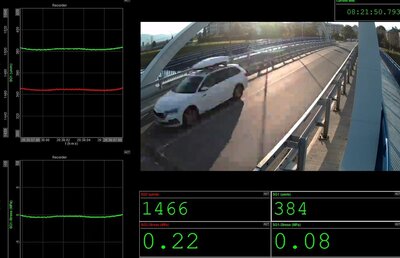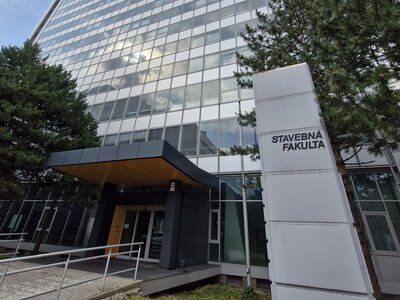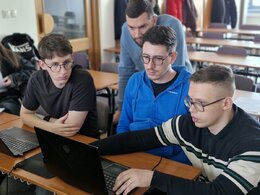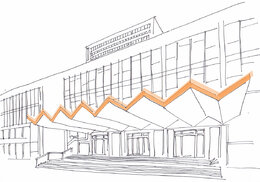♦ Sandwich panels with mineral wool filling (2019)The research was solved within the VEGA project and the dissertation. As part of research into the resistance of composite materials in KKDK laboratories, we carry out load tests of sandwich panels with mineral wool filling from the BRUCHA company. We have panels measuring 4000 x 1100 x 120 mm and 4000 x 1100 x 150 mm. The loading was realized in four pools, where the surface load was simulated using the water level.
The value of 3,5 kN/m2 was reached during the experimental loading, which was 2,5 times the table value. The deflection was below 20 mm. Based on these results, it is necessary to increase the pools in order to derive the load required to break the panels. During loading, the deflection in the middle of the beam and 500 mm on each side towards the supports was monitored. The stress in the middle of the beam at the upper and lower edges was also monitored. In further experiments, the number of strain gauges will be increased. |
♦ Slip joints in edged steel masts (2017 – 2019)The research was solved within the VEGA project and the dissertation. A total of three types of samples were tested, the variable factor was the length of insertion - for type 1 it was equal to the diameter of the mast, for type 2 1.2 times and for type 3 1.5 times. The purpose of the experiment was to measure the tangential stress in the wall of the mast shaft under the simultaneous action of axial force and bending moment. In the second part of the experiment, the column is fixed to the floor and then a lateral load is derived by means of a press and a set of pulleys. In the first step, the connection with the maximum insertion is equipped with a set of strain gauges to determine the stress distribution. The amount of column deflection at the levels below the joint, at the joint, above the joint and at the top is also monitored. A change in the overlap length under the action of force is also recorded. In the next steps, it is possible to derive a vertical force by means of weights placed on the horizontal arms of the mast located at its apex, as well as a torsion which is introduced by means of the same arms.Currently is running another research that is based and proceeds on already obtained results in the slip joints.
|
♦ Material tests of timber (2018)Project leaders: Klas T., Sandanus J., Surovec L. The research was solved within the VEGA project and the dissertation. Material tests of timber elements were performed on samples obtained from surpluses after cutting the original samples 100 x 200 x 200 mm into the tested 100 x 100 x 140 mm. 10 specimens for tensile stress and 12 specimens for compressive stress were made. The tensile specimens had dimensions of 10 x 10 x 200 mm and for a pressure of 30 x 30 x 200 mm.
|
♦ Composite timber and concrete beams (2017)Project leaders: Klas T., Sandanus J., Slivanský M., Surovec L. The research was solved within the VEGA project and the dissertation. A total of six samples of composite beams were tested. To determine the maximum resistance of the composite beams, two samples were tested at each stage by a four-point bending to failure. The last sample from each stage was tested to a value of 50% of the theoretical resistance of the beams and was subsequently set aside for long-term measurement.
|
♦ Experimental test by four-point bending of glass (2016)The research was solved within the VEGA project and the dissertation. The task of the experimental test was to determine the Young's modulus of elasticity of the glass Es, to measure the maximum stress and the corresponding deflection in the middle of the glass pane. |
♦ Experimental impact test of glass (2016)The research was solved within the VEGA project and the dissertation. The experiment was carried out in order to test the impact resistance of glass sheets (short-term dynamic loading) during the behaviour without failure and the method of failure of samples (crack propagation).
Strains, deflections and accelerometric acceleration measurements were measured. The oscillation frequencies of the glass sheets after the impact were also measured. The measured frequencies on the samples made of monolithic glass with a thickness of 6 mm, laminated glass and laminated old glass were completely identical to each other. The sample of laminated glass had the greatest rigidity, followed by a sample of monolithic glass with a thickness of 6 mm and finally a sample of a pair of sheets without gluing. When the samples consisting of monolithic glass (unlaminated) were broken, a large number of sharp fragments were released. The speed of the fragments was measured to be 18 m/s. After breaking the sample, only a small part of the original sample remained in the clamping frame. In the case of laminated glass, the sample (including the PVB film) was punctured, but there was almost no release of fragments. With a pair of glass panes (without gluing), the front pane always broke. |
♦Determination of load-bearing capacity of cross-laminated timber beams (2016)Project leaders: Katona O., Klas T., Sandanus J. The research was solved within the VEGA project and the dissertation. During the bending test, the maximum force and the corresponding deflection in the event of a beam failure were determined. There were always three beams of each type. These were three-layer CLT beams 100 mm thick, from which samples 2950 mm long were cut. The beams had a height of 300 mm and 600 mm. The specimens were placed in a loading frame and loaded with a four-point bend.
|
♦ Joints of timber structures using glued bars (2016)Project leaders: Duchoň V., Klas T., Sandanus J. The research was solved within the VEGA project and the dissertation. In the experimental analysis, 10 beams with dimensions of 150x180x3200 mm were prepared, which were divided in the middle of the span. Their reconnection was realized by means of glued threaded rods. Three holes for bars with strength class 8.8 were placed in the tensile zone. Two holes for bars with strength class 4.6 were placed in the pressure zone. Holes with a diameter of 14 mm were drilled to a depth of 200 mm. HILTI HIT-RE 500 glue was used for gluing the bars, the application of which using an automatic gun proved to be the fastest due to the number of samples. The mechanical properties of the adhesive were verified by means of four tensile tests. In these tests, the highest value of tensile strength of 86,2 kN was achieved, when the adhesive was broken by shear. Half of the beams were made of grown timber and the other half of glued laminated timber. During gluing, the beams were leveled with a steel guide profile and tightened with timber connecting plates. An important detail when gluing the beams was to avoid the formation of a gap in the pressed zone, which would adversely affect the curve expressing the rotation of the joint. If there is a risk of this because of the beam faces uneveness, the gaps were filled with glue.
The achieved results were processed into tables and graphs, which clearly describe the measured values. The individual beams achieved approximately the same results, but in some cases they were affected by boundary conditions, which depended on the quality of the joints and the inhomogeneous structure of the timber. |
♦ Joints of timber structures using glued bars (2015)Project leaders: Duchoň V., Klas T., Sandanus J. The research was solved within the VEGA project and the dissertation. The experiment was focused on determining the required depth of gluing the threaded rod into the drilled hole of a timber element with dimensions of 140x140x500 mm. Two types of two-component adhesives have also been used. The first was the epoxy-based STADO CARBO RESIN adhesive from PBSan. The second type of NEOPUR 2744 from Agglu is based on polyurethane. The setting time of the adhesives was at least 7 days for each sample. Thus, 16 samples were created (for each adhesive 8), where the gluing depth of the rod varied from 150 to 300 mm and the diameter of the rod 12 and 14 mm.
The samples thus prepared were placed in a press with a capacity of 100 kN and the first round of experiments took place. Based on them, the types of gluing depth were selected and another 18 samples were prepared to verify the achieved results. All tests were performed until the joint broke. There were three types of failure. Tearing of the threaded rod, breaking of the timber fibers in the vicinity of the glued element, or breaking of the adhesive itself by shearing. In the vicinity of the hole, tensile stresses arise in the timber fibers; after exceeding the tensile strength, the resistance is realized by means of shear strength between the timber fibers. For this reason, the gluing depth of the rod is decisive for the resistance of the joint.
|
♦ Verification of elastomeric reinforced bearings (2015)The research was solved within the VEGA project and the dissertation. In this experiment, four types of square (100 x 100 mm) and four types of rectangular (100 x 150 mm) reinforced elastomeric bearings were investigated. In these four types, the method of reinforcement changed. At first, each bearing was individually loaded with a vertical compressive force. This compressive force varied for each bearing depending on the type of reinforcement and the floor area of the bearing. Bearing deformation was monitored in this experiment. The second type of load was a vertical and horizontal force, and in the third case the load was a vertical force and a bend.
|
♦ Influence of cracks on the properties of beams from grown and glued laminated timber (2015)The research was solved in cooperation with the Department of Structural Mechanics within the VEGA project and the dissertation. This experiment was carried out as a support for verification computational programs aimed at crack propagation in timber elements. For the purpose of the experiment, four types of failure were selected (vertical crack 25 mm deep, oblique crack 25 mm deep, dropped lumps 20 mm in diameter and horizontal crack 20 mm deep and 60 mm long) and an intact sample for control. The whole series was made of grown and also glued laminated timber measuring 160 x 100 mm. The samples were loaded by four-point bending in a press with a capacity of 100 kN. |
Older projects |
|
|
|
|
|
|
|
|
|
|
|































